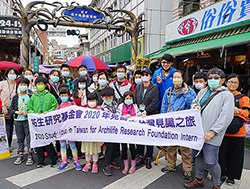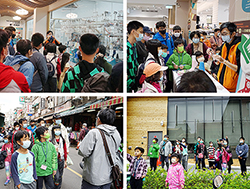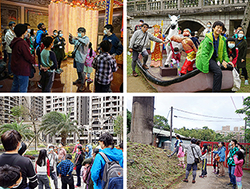
12月份見識之旅活動,於2020年12月6日由呂明澐小姐帶領23位祐生見習生及家長們,進行臺北盆地守護者:你所不知道的林口臺地探索之旅。活動開始之初,領隊呂明澐小姐提醒本次活動注意事項及觀察重點,先行建立見習生的背景知識。
For the study tour of December 6, 2020, Ms. Lu Ming-yun led 23 ARF interns and their parents on a trip to discover Linkou Plateau, guardian of the Taipei basin. At the start of the day's activities, team leader Ms. Lu Ming-yun reminded everyone about things to note and what to observe, and gave the interns some background knowledge.

本次行程以參訪林口臺地為主軸,由高傳棋先生擔任導覽老師。行程一開始前往吳福洋襪子故事館,該館係製襪工廠轉型成立的觀光工廠。首先由館內導覽人員帶領眾人觀看師傅操作機台認識襪子織造流程,說明有些襪子容易鬆脫可能是廠商基於成本考量,使用單一尺寸的機台織造,再加工拉大成其他尺寸。接著進行簡單的燃燒實驗來辨識天然纖維與人造纖維,前者靠近火焰時會捲曲,燃燒後餘深色灰燼;後者會冒黑煙,產生刺鼻臭味,燃燒後呈黑色硬塊。隨後前往林口路藝術商街,該商街與一旁的林口老街為早期商業發展的要道,市集買賣皆聚集於此,至今仍是人聲鼎沸的早市所在地。走訪過程中,高老師沿途介紹街上的舊式建築,並舉林口公有市場為例,說明今昔樣貌之變化。此外,清代時期在人口密集的街道頭尾通常各有一座土地公廟,除了信仰需求,亦有類似鄰里守望相助的作用,日治時期即在土地公廟周遭設立派出所,以方便人口管理。
Focusing on the Linkou Plateau, the trip was led by Mr. Gao Chuan-chi. The day's itinerary began at Wu Fu Yang Taiwan's Socks Museum. The museum was formerly a sock factory. Museum tour guide brought everyone around the factory to learn the process of sock knitting. According to the tour guide, some socks loosen easily because manufacturers cut costs by using a single-size machine to manufacture socks in one size which are then pulled into different sizes later. Everyone also watched an experiment to differentiate between natural fiber and synthetic fiber – the former curls up when placed near a flame and leaves a dark residue after burning, whereas the latter will produce black smoke and pungent odor and leaves black solid pieces after burning. After leaving the museum, everyone proceeded to the Arts Street at Linkou Road. Both the Arts Street and the adjacent Linkou Old Street were main thoroughfares in the early days of business development and the bulk of trading activities took place there. It is still the location of a bustling morning market today. During the tour, Mr. Gao introduced old-style architectures on the streets and pointed out the transformation over time using Linkou public market as an example. He also said that a temple of Earth God was often found at each end of highly populated streets in the Qing Dynasty. They were not only used to fulfill religious needs but also served as neighborhood watch. In fact, during the Japanese Occupation, police stations were established near these temples to facilitate population management.

下午前往竹林山觀音寺參訪,該廟宇是林口在地的信仰中心,於民國三十八年竣工,十年前動土擴建,是以現在眼前所見為翻新後的樣貌,廟內精美的石刻有部分為信眾捐獻,由此可見其香火鼎盛。隨後前往干城二村眷村舊址,目前已都更完畢,密集的大樓多是剛落成幾年的新式住宅,對應附近的鐵皮屋及農田,成為特有的景觀。走訪過程中,高老師特別指出林口臺地因淋溶作用旺盛,形成特有的紅土層,紅土在林口早期經濟發展上扮演重要的角色,當時茶園及紅磚窯燒製造十分繁盛,後來由於產業變遷及其他政策因素,傳統磚窯產業逐漸沒落。行程最後來到林口磚窯遺址,由於前述原因,該磚窯多年未使用而荒廢,已於今年拆除,僅餘一根煙囪,來不及列入相關文化資產保護,甚為可惜,相關在地文化保存議題值得眾人深思。至此,本日活動已近尾聲,大家一起合照留念後搭車返程,並期待於下次見識之旅再相見。
In the afternoon, everyone visited Zhulinshan Guanyin Temple, which is the center of faith in Linkou. Built in 1949, its current appearance was the result of an expansion 10 years ago. Some of the exquisite stone carvings in the temple have been donated by believers, which is testimony to the temple's popularity. Everyone then proceeded to the old location of Kancheng Second Village. As it had completed its urban renewal process, most of the tightly packed buildings are new-style residential buildings that are only several years old, which made a quaint contrast to the surrounding sheet metal shacks and farmlands. During the tour, Mr. Gao especially pointed out that Linkou Plateau's vigorous leaching, has resulted in the formation of its unique laterite. Laterite played a pivotal role in Linkou's economic development in the early days due to the proliferation of tea plantations and red brick kilns. However, the traditional brick kiln industry gradually declined due to industrial transformation and other policy factors. The last leg of the tour brought everyone to the historic site of Linkou brick kiln, which has been long neglected and unused for years due to the above reasons. Much of its structure has been demolished this year, leaving only a chimney. Regretfully, there was not enough time to put it under conservation as a cultural asset, making the preservation of local culture a though-worthy issue. At this point, the day's itinerary came to an end. Everyone took a group photo before heading back and looked forward to the next study tour.